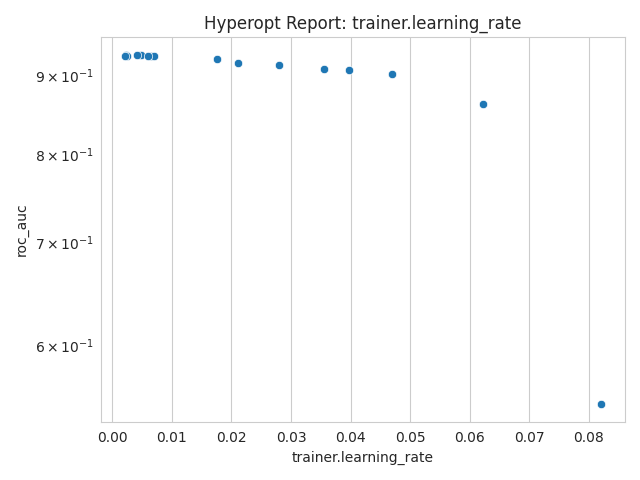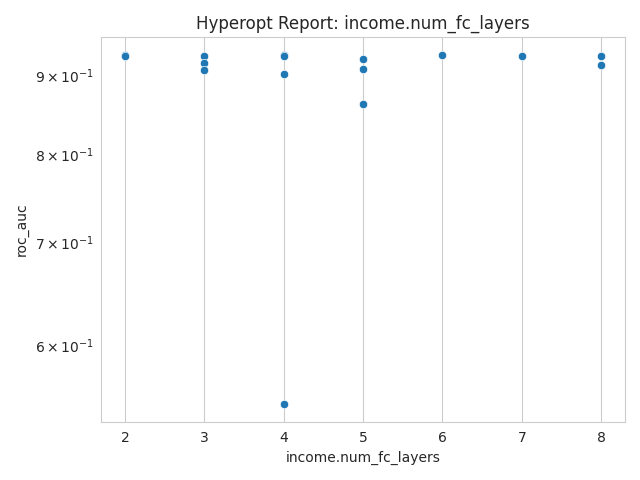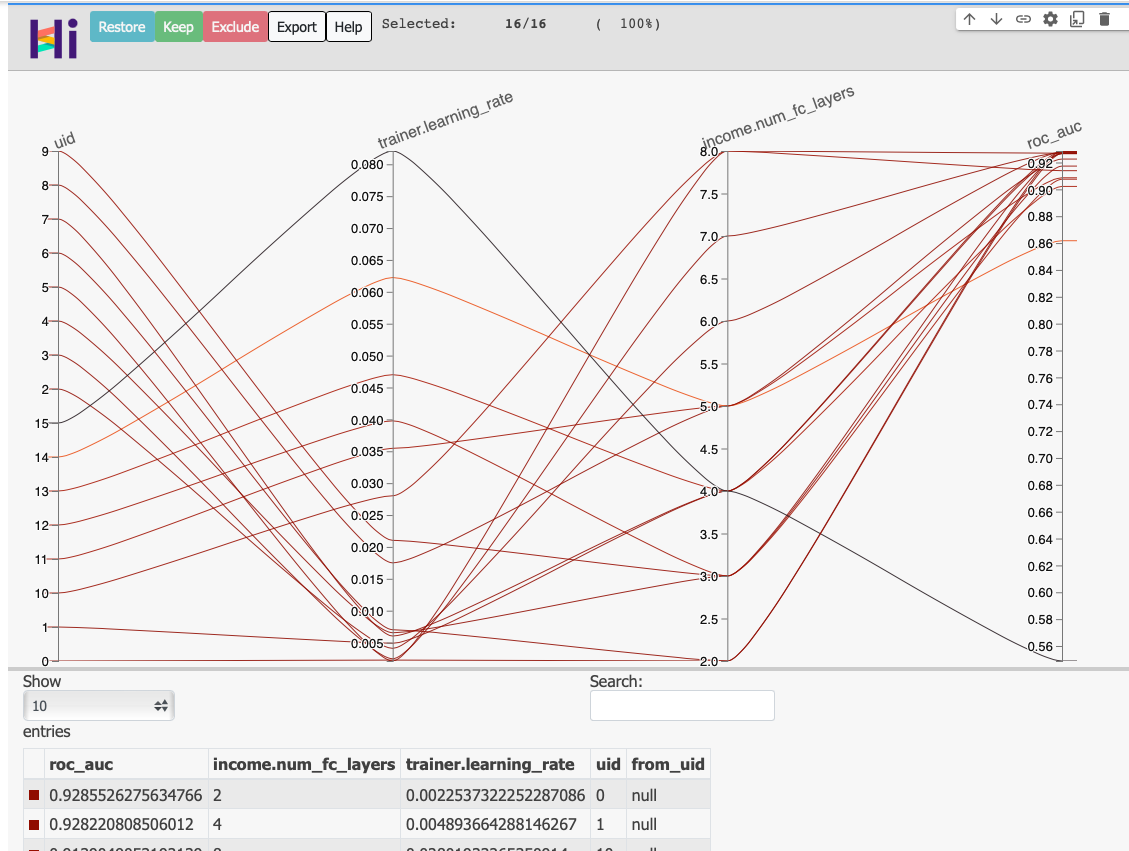Hyperparameter Optimization
This is a complete example of Ludwig's hyperparameter optimization capability.
These interactive notebooks follow the steps of this example:
Download the Adult Census Income dataset¶
Adult Census Income is an extract of 1994 Census data for predicting whether a person's income exceeds $50K per year. The data set consists of over 49K records with 14 attributes with missing data.
ludwig datasets download adult_census_income
This command will create a dataset adult_census_income.csv in the current directory.
The columns in the dataset are
| column | description |
|---|---|
| age | numeric variable, age of person |
| workclass | categorical variable, Type of empolyment |
| fnlwgt | numeric variable, no defintion |
| education | categorical variable, education level |
| education-num | nmeric variable, no definition |
| marital-status | categorical variable, marital status |
| occupation | categorical variable, occupation |
| relationship | categorical variable, Relationship to household |
| race | categorical variable, race |
| sex | categorical variable, gender |
| capital-gain | numeric variable, no definition |
| capital-loss | numeric variable, no definition |
| hours-per-week | numeric variable, hours worked per week |
| native-country | categorical variable, Country of origin |
| income | binary variable, " <=50K" or " >50K" |
| split | numeric variable, indicating data split training(0), test(2) |
Setup for hyperparameter optimization run¶
Hyperparameter optimization is defined with the hyperopt section of the Ludwig configuration specification.
preprocessing:
...
input_features:
...
combiner:
...
output_features:
...
trainer:
...
# hyperopt specification
hyperopt:
# specify parameters for the Ray Tune to executor to run the hyperparameter optimization
executor:
...
# specify Ray Tune search algorithm to use
search_alg:
...
# hyperparameter search space for the optimization
parameters:
...
# minimize or maximize the metric score
goal: ...
# metric score to optimize
metric: ...
# name of the output feature
output_feature: ...
# define model configuration
config = {
'combiner': ... ,
'input_features': ... ,
'output_features': ... ,
'preprocessing': ...,
'trainer':... ,
# hyperopt specification
'hyperopt': {
# specify parameters for the Ray Tune to executor to run the hyperparameter optimization
'executor': {'type': 'ray', ... },
# specify Ray Tune search algorithm to use
'search_alg': {... },
# hyperparameter search space for the optimization
'parameters': {...},
# minimize or maximize the metric score
'goal': ...,
# metric score to optimize
'metric': ...,
# name of the output feature
'output_feature': ...,
}
}
Hyperparameter Search Space Specification¶
For this example, we want to determine the effect of Ludwig's Trainer's learning_rate and num_fc_layers of the income output feature on model's roc_auc metric. To do this we will use two different hyperparameter optimization approaches: Random Search and Grid Search.
Random Search¶
hyperopt:
executor:
num_samples: 16
goal: maximize
metric: roc_auc
output_feature: income
parameters:
income.num_fc_layers:
space: randint
lower: 2
upper: 9
trainer.learning_rate:
space: loguniform
lower: 0.001
upper: 0.1
search_alg:
type: variant_generator
random_state: 1919
'hyperopt': {
'executor': {'num_samples': 16, },
'goal': 'maximize',
'metric': 'roc_auc',
'output_feature': 'income',
'parameters': {
'income.num_fc_layers': {
'space': 'randint',
'lower': 2,
'upper': 9
},
'trainer.learning_rate': {
'space': 'loguniform',
'lower': 0.001,
'upper': 0.1}
},
'search_alg': {'type': 'variant_generator', 'random_state': 1919, }
},
Grid Search¶
hyperopt:
executor:
num_samples: 1
goal: maximize
metric: roc_auc
output_feature: income
parameters:
income.num_fc_layers:
space: grid_search
values: [2, 4, 6, 8]
trainer.learning_rate:
space: grid_search
values: [0.001, 0.003, 0.007, 0.01]
search_alg:
type: variant_generator
random_state: 1919
'hyperopt': {
'executor': {'num_samples': 1,},
'goal': 'maximize',
'metric': 'roc_auc',
'output_feature': 'income',
'parameters': {
'income.num_fc_layers': {'space': 'grid_search', 'values': [2, 4, 6, 8]},
'trainer.learning_rate': {'space': 'grid_search', 'values': [0.001, 0.003, 0.007, 0.01]}},
'search_alg': {'type': 'variant_generator', 'random_state': 1919, }
},
Run Hyperparameter Optimization¶
Here are example commands/function call to run Ludwig's hyperparameter optimization capability.
ludwig hyperopt --dataset adult_census_income.csv \
--config config.yaml \
--output_directory results \
--hyperopt_log_verbosity 1
hyperopt_results = hyperopt(
config,
dataset=adult_census_df,
output_directory="results",
hyperopt_log_verbosity=1
)
Visualize Hyperparameter Optimization Results¶
ludwig visualize hyperopt_report command
ludwig visualize hyperopt_hiplot command
# generate visualizations on hyperparameter effects on the metric
ludwig visualize --visualization hyperopt_report \
--hyperopt_stats_path results/hyperopt_statistics.json \
--output_directory visualizations \
--file_format png
# generate hyperopt hiplot parallel coordinate visualization
ludwig visualize --visualization hyperopt_hiplot \
--hyperopt_stats_path results/hyperopt_statistics.json \
--output_directory visualizations
visualize.hyperopt_report() function
visualize.hyperopt_hiplot() function
hyperopt_report("./rs_output/hyperopt_statistics.json")
hyperopt_hiplot("./rs_output/hyperopt_statistics.json", output_directory="visualizations")
hyperopt_report¶



hyperopt_hiplot¶
